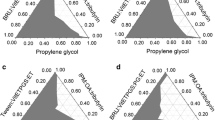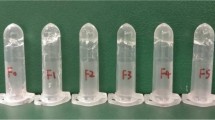Abstract
Microemulsions (ME)—nanostructured systems composed of water, oil, and surfactants—have frequently been used in attempts to increase cutaneous drug delivery. The primary objective addressed in this work has been the development of temperature-sensitive microemulsion gel (called gel-like ME), as an effective and safe delivery system suitable for simultaneous topical application of a hydrophilic vitamin C and a lipophilic vitamin E. By changing water content of liquid o/w ME (o/w ME), a gel-like ME with temperature-sensitive rheological properties was formed. The temperature-driven changes in its microstructure were confirmed by rotational rheometry, viscosity measurements, and droplet size determination. The release studies have shown that the vitamins’ release at skin temperature from gel-like ME were comparable to those from o/w ME and were much faster and more complete than from o/w ME conventionally thickened with polymer (o/w ME carbomer). According to effectiveness in skin delivery of both vitamins, o/w ME was found the most appropriate, followed by gel-like ME and by o/w ME carbomer, indicating that no simple correlation between vitamins release and skin absorption could be found. The cytotoxicity studies revealed good cell viability after exposure to ME and confirmed all tested microemulsions as nonirritant.






Similar content being viewed by others
References
M. Kreilgaard. Influence of microemulsions on cutaneous drug delivery. Adv. Drug Del. Rev. 54 Suppl 1:S77–S98 (2002).
K. Welin-Berger, J. Neelissen, and B. Bergenstahl. In vitro permeation profile of a local anaesthetic compound from topical formulations with different rheological behaviour-verified by in vivo efficacy data. Eur. J. Pharm. Sci. 14:229–236 (2001).
D. Libster, A. Aserin, and N. Garti. A novel dispersion method comprising a nucleating agent solubilized in a microemulsion, in polymeric matrix I. Dispersion method and polymer characterization. J. Colloid Interface Sci. 299:172–181 (2006).
G. M. Eccleston. Microemulsions. In J. Swarbirck, and J. C. Boylan (eds.), Encyclopedia of Pharmaceutical Technology, Dekker, New York, 1994, pp. 411–412.
P. Spiclin, M. Homar, A. Zupancic-Valant, and M. Gasperlin. Sodium ascorbyl phosphate in topical microemulsions. Int. J. Pharm. 256:65–73 (2003).
V. M. Adhami, D. N. Syed, N. Khan, and F. Afaq. Phytochemicals for prevention of solar ultraviolet radiation-induced damages. Photochem. Photobiol. 84:489–500 (2008).
A. Svobodova, D. Walterova, and J. Vostalova. Ultraviolet light induced alteration to the skin. Biomed. Pap. Med. Fac. Palacky Univ. Olomouc Czech Repub. 150:25–38 (2006).
K. E. Burke. Interaction of vitamins C and E as better cosmeceuticals. Dermatol. Ther. 20:314–321 (2007).
M. P. Lupo. Antioxidants and vitamins in cosmetics. Clin. Dermatol. 19:467–473 (2001).
J. Y. Lin, M. A. Selim, C. R. Shea, J. M. Grichnik, M. M. Omar, N. A. Monteiro-Riviere, and S. R. Pinnell. UV photoprotection by combination topical antioxidants vitamin C and vitamin E. J. Am. Acad. Dermatol. 48:866–874 (2003).
E. Niki, N. Noguchi, H. Tsuchihashi, and N. Gotoh. Interaction among vitamin C, vitamin E, and beta-carotene. Am. J. Clin. Nutr. 62:1322S–1326S (1995).
A. Spernath, and A. Aserin. Microemulsions as carriers for drugs and nutraceuticals. Adv. Colloid Interface Sci. 128–130:47–64 (2006).
I. P. Kaur, M. Kapila, and R. Agrawal. Role of novel delivery systems in developing topical antioxidants as therapeutics to combat photoageing. Ageing Res. Rev. 6:271–288 (2007).
G. Bonacucina, M. Cespi, M. Misici-Falzi, and G. F. Palmieri. Colloidal soft matter as drug delivery system. J. Pharm. Sci. 981:1–42 (2008).
J. Kristl, K. Teskac, M. Milek, and I. Mlinaric-Rascan. Surface active stabilizer Tyloxapol in colloidal dispersions exerts cytostatic effects and apoptotic dismissal of cells. Toxicol. Appl. Pharmacol. 2322:218–225 (2008).
M. Tomsic, F. Podlogar, M. Gasperlin, M. Bester-Rogac, and A. Jamnik. Water-Tween 40/Imwitor 308-isopropyl myristate microemulsions as delivery systems for ketoprofen: small-angle X-ray scattering study. Int. J. Pharm. 327:170–177 (2006).
F. Podlogar, M. Bester Rogac, and M. Gasperlin. The effect of internal structure of selected water-Tween 40-Imwitor 308-IPM microemulsions on ketoprofene release. Int. J. Pharm. 302:68–77 (2005).
J. J. Koleng, J. W. McGinity, and W. R. Wilber. Carbomer. In R. C. Rowe, P. J. Sheskey, and P. J. Weller (eds.), Handbook of Pharmaceutical Excipients, Pharmaceutical, London, 2003, pp. 89–91.
A. R. Lee, and K. Tojo. An experimental approach to study the binding properties of vitamin E (alpha-tocopherol) during hairless mouse skin permeation. Chem. Pharm. Bull. 49:659–663 (2001).
H. Guo, Z. Liu, J. Li, S. Nie, and W. Pan. Effects of isopropyl palmitate on the skin permeation of drugs. Biol. Pharm. Bull. 29:2324–2326 (2006).
C. Caddeo, K. Teskac, C. Sinico, and J. Kristl. Effect of resveratrol incorporated in liposomes on proliferation and UV-B protection of cells. Int. J. Pharm. 3631–2:183–191 (2008).
Acknowledgment
Authors would like to thank Prof. Hans E. Junginger for helpful discussion. We are grateful to assistant Karmen Teskač for her assistance with fluorescence microscope.
Author information
Authors and Affiliations
Corresponding author
Additional information
This work was supported by a grant of Slovenian Research Agency.
Rights and permissions
About this article
Cite this article
Rozman, B., Zvonar, A., Falson, F. et al. Temperature-Sensitive Microemulsion Gel: An Effective Topical Delivery System for Simultaneous Delivery of Vitamins C and E. AAPS PharmSciTech 10, 54–61 (2009). https://doi.org/10.1208/s12249-008-9172-3
Received:
Accepted:
Published:
Issue Date:
DOI: https://doi.org/10.1208/s12249-008-9172-3




